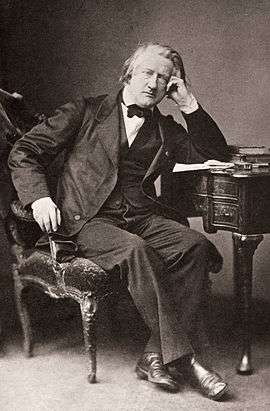Henri Victor Regnault
| Henri Victor Regnault | |
|---|---|
|
Henri Victor Regnault | |
| Born |
21 July 1810 Aachen |
| Died |
19 January 1878 (aged 67) Auteuil (now a part of Paris) |
| Nationality | France |
| Fields | thermodynamics |
| Alma mater | École Polytechnique |
| Influences | Justus von Liebig |
| Influenced | William Thomson |
| Notable awards |
Rumford Medal (1848) Copley Medal (1869) Matteucci Medal (1875) |
Henri Victor Regnault (21 July 1810 – 19 January 1878) was a French chemist and physicist best known for his careful measurements of the thermal properties of gases. He was an early thermodynamicist and was mentor to William Thomson in the late 1840s.
Biography
Born in Aachen in 1810, he moved to Paris at the age of eight, following the death of his parents. There, he worked for an upholstery firm until he was eighteen. In 1830, he was admitted to the École Polytechnique, and in 1832 he graduated from the École des mines.
Working under Justus von Liebig at Gießen, Regnault distinguished himself in the nascent field of organic chemistry by synthesizing several chlorinated hydrocarbons (e.g. vinyl chloride, polyvinylidene chloride, dichloromethane), and he was appointed professor of chemistry at the University of Lyon. In 1840, he was appointed the chair of chemistry of the École Polytechnique, and in 1841, he became a professor of Physics in the Collège de France.
Beginning in 1843, he began compiling extensive numerical tables on the properties of steam. These were published in 1847, and led to his receiving the Rumford Medal of the Royal Society of London and appointment as Chief Engineer of Mines. In 1851 he was elected a foreign member of the Royal Swedish Academy of Sciences. In 1854 he was appointed director of the porcelain works at Sèvres, the Manufacture nationale de Sèvres.
At Sèvres, he continued work on the thermal properties of matter. He designed sensitive thermometers, hygrometers, hypsometers and calorimeters, and measured the specific heats of many substances and the coefficient of thermal expansion of gases. In the course of this work, he discovered that not all gases expand equally when heated and that Boyle's Law is only an approximation, especially at temperatures near a substance's boiling point.
Regnault was also an avid amateur photographer. He introduced the use of pyrogallic acid as a developing agent, and was one of the first photographers to use paper negatives. In 1854, he became the founding president of the Société française de photographie.
In 1871, his laboratory at Sèvres was destroyed and his son Alex-Georges-Henri Regnault killed, both as a result of the Franco-Prussian War. He retired from science the next year, never recovering from these losses.
Legacy
The crater Regnault on the Moon is named after Regnault, and his name is one of the 72 names inscribed on the Eiffel Tower. Some have suggested that the symbol R for the ideal gas constant is also named after him.[1]
He was the first president of Société française de photographie.
Works
- Regnault-Strecker's kurzes Lehrbuch der Chemie. Vieweg, Braunschweig 1851 Digital edition by the University and State Library Düsseldorf
References
| Wikimedia Commons has media related to Henri Victor Regnault. |
- ↑ Jensen, William B. (July 2003). "The Universal Gas Constant R" (PDF). Chemical Education Today. 80 (7): 731.
| Wikisource has the text of the 1913 Catholic Encyclopedia article Henri Victor Regnault. |
